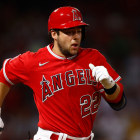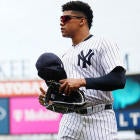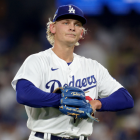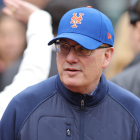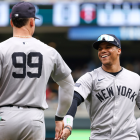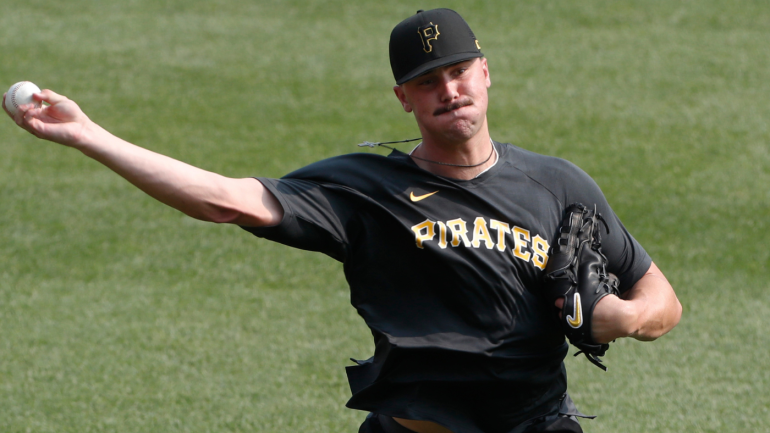
July has become the busiest month on Major League Baseball's schedule. It begins with the first-year amateur draft, displaced from its previous June home to coincide with the All-Star break, and oftentimes ends with a flurry of activity and speculation leading up to the trade deadline. (Astute readers will note that the deadline has not actually passed in July in recent years.)
With the draft-pick signing and trade deadline now in the rearview mirror, we here at CBS Sports figured we'd kick off the post-noise part of the schedule by highlighting the teams who found their new top prospect in recent weeks. That can be through the draft or trade -- either acquiring a new one, or shipping out the old top one, thereby leaving someone else in the catbird seat.
Do note that these are subjective rankings, and that they might change between now and the publication of our offseason lists. Such is the nature of player evaluation: it's a constant, fluid process. With that out of the way, let's get to it.
Through the draft
1. Paul Skenes, RHP, Pittsburgh Pirates
- Drafted No. 1 overall from LSU
Skenes' LSU teammate, outfielder Dylan Crews, was widely considered the best prospect in the draft. The Pirates went instead with Skenes, and then paid him the highest signing bonus in the class to prove their decision wasn't about money.
First 7 pitches of the College World Series for @LSUbaseball’s Paul Skenes, culminating in this K.
— MLB Pipeline (@MLBPipeline) June 17, 2023
100
100
100
100
101
101
102pic.twitter.com/KscNUV2hz3
Skenes is a strapping righty with elite velocity and a swing-and-miss slider. He struck out 48% of the batters he faced in SEC play, shutting out any concerns evaluators had about how his game would transfer to college's toughest circuit. (He'd previously played at Air Force.) The next concern facing Skenes is how his fastball shape will play against professional hitters. The Pirates are optimistic that his combination of velocity and command will render that a moot point. If so, he has front-of-the-rotation upside, and he could debut as soon as next season.
2. Max Clark, CF, Detroit Tigers
- Drafted No. 3 overall from Franklin Community HS (IN)
Although one of the top three collegiates remained on the board (Skenes, Crews, and Florida outfielder Wyatt Langford), the Tigers went with Clark instead. Clark, who elicits comparisons to Cubs outfield prospect Pete Crow-Armstrong, has a lot going for him. He can really run and he should be an asset in center field for the long haul. He's also shown an advanced feel for hitting, though his ultimate offensive upside will hinge on how much power he develops.
Through trade (arrival)
3. Luisangel Acuña, INF, New York Mets
- Acquired from the Texas Rangers for RHP Max Scherzer
Acuña, the younger brother of Braves star Ronald, is a smallish infielder who has already achieved success at Double-A. He has above-average power potential, but his in-game slugging output has been capped by a combination of an aggressive approach and a tendency to top the ball into the ground.
Luisangel Acuña gets his first hit in the Mets organization pic.twitter.com/NCURiuL40T
— SNY Mets (@SNY_Mets) August 3, 2023
Defensively, he seems likely to move off shortstop -- not because of any skill-set deficiencies; just because the Mets have Francisco Lindor around to man the six. It's to be seen if Acuña will remain with the Mets heading forward or if he'll be dealt again this winter. Regardless, he should make his big-league debut sometime next summer.
4. Kyle Manzardo, 1B, Cleveland Guardians
- Acquired from the Tampa Bay Rays for RHP Aaron Civale
(Note: right-hander Gavin Williams is a few innings away from exhausting his prospect eligibility, so we're taking liberties by preemptively including the Guardians.) Manzardo, sidelined with an undisclosed injury, is a polarizing prospect. First basemen without plus or better power projections are viewed as favorably as dentists with more teeth than clients. Generally, those kinds of players have to possess high-end hit tools and approaches to make it work. Manzardo just might have both. He's performed at every level he's been tasked with, including this season at Triple-A. Manzardo excelled against right-handed pitchers prior to his injury, and his ball-tracking data suggests his miserable line versus lefties was at least in part fueled by some poor luck. Depending on when he returns from what ails him, he could make his debut as soon as this year.
Through trade (departure)
5. Nolan Schanuel, 1B, Los Angeles Angels
- Drafted No. 11 overall from Florida Atlantic (2023)
- Previous No. 1 Angels prospect, C Edgar Quero, was traded to the Chicago White Sox as part of a deal for RHP Lucas Giolito and RHP Reynaldo López
The Angels didn't enter July with a particularly strong farm system. They weakened it further with a series of trades designed to make one more push with Shohei Ohtani. Fair enough. As a result of all the wheeling and dealing, Schanuel might enter next spring viewed as the best young player on the farm. He didn't post top-end exit velocity numbers at FAU, and he has an unusual batting stance that sees him hold his hands up high before beginning his load. He still produced hit after hit like some kind of baseballing Quincy Jones.
Nolan Schanuel is a hitting machine!
— Minor League Baseball (@MiLB) August 2, 2023
The @Angels first-rounder (11th overall) collects his second straight three-hit game for the @trashpandas, highlighted by this double: pic.twitter.com/ErYPh66iGb
Schanuel has since been subjected to Perry Minasian's fast-tracking ways: he's already up to the Double-A level, where he's hit .350/.435/.500 in his first 23 trips to the plate. Given how Minasian pushed Zach Neto through the system, we have to believe Schanuel could make his big-league debut as early as next spring if he keeps on hitting.
6. Zach Dezenzo, INF, Houston Astros
- Drafted No. 373 overall from the Ohio State University (2022)
- Previous No. 1 Astros prospect, OF Drew Gilbert, was traded to the New York Mets as part of a deal for RHP Justin Verlander
The Astros, like their American League West rivals above, don't have a strong farm system in place. Dezenzo has made a quick ascent after making several mechanical changes since draft day. That's allowed him to spend half of his first full professional season in Double-A, where he's hitting .260/.333/.480 with six home runs in 32 games. There are valid concerns about Dezenzo's long-term outlook as it pertains to his position (he's played all over but is probably heading for a not-so-hot corner) and his hit tool. He hits the ball extremely hard, however, and that plus him more than holding his own at Double-A (essentially the proving ground level) bodes well for his chances of having a worthwhile big-league future

















